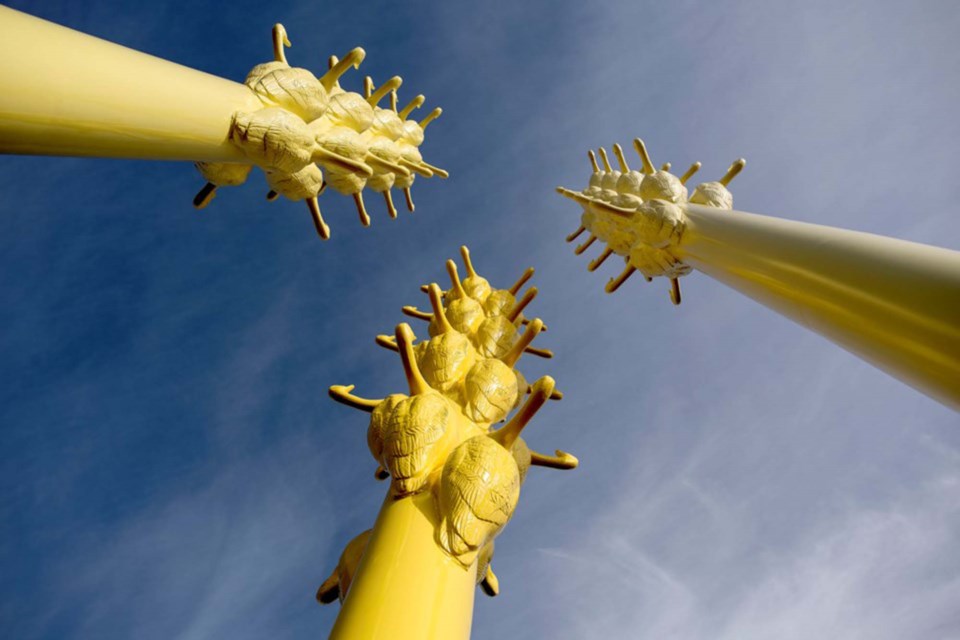St. Albert could be holding off on putting money into its public-art reserve for the third year in a row, according to the 2022 draft budget released Nov. 3.
Every year, the city can transfer up to $220,000 from its capital reserve to fund the purchase and maintenance of public-art displays. Instead, this year, the funding might be used as part of a range of measures to offset the proposed tax increase.
St. Albert’s chief administrative officer Kevin Scoble told councillors on Nov. 3 the city found measures to reduce the tax increase from 7.5 to 2.5 per cent. Also proposed in the draft budget is a utility increase of 4.5 per cent, which would amount to an additional $5.97 per month on the average utility bill.
Other measures the city is looking at to reduce the tax increase include but are not limited to proposed service reductions, and applying $2.5 million in one-time COVID-19 relief funding to the tax base.
Elizabeth Wilke, director of community services for the city, said part of the reason the draft budget does not include a contribution to the public-art reserve this year is there is already enough funding for public-art projects planned for 2022.
These projects include a temporary month-long art installation to kick off the children’s festival which will remain in the community three weeks afterward, and a diversity and inclusion project approved by the previous council.
While the former project is already planned, the diversity and inclusion project’s planning has been on hold due to COVID-19.
“Because of the need to bring the community together in-person for that [project’s planning], it’s been paused,” Wilke said. “In the start of the year, we will likely have a request for proposals for artist-led engagement with the community.”
A third project potentially beginning in 2022 will be part of the city’s pandemic response, Wilke said.
“When we get into the new year and past this fourth wave, we’ll start having conversations with both the arts development advisory committee and the community around … how they would like to mark their resilience and their experience through public art,” Wilke said.
The arts development advisory committee was created in 2020 to give residents a say in how dollars are spent on public arts. In addition to guiding how the public-art reserve is spent, the committee also supports the development of the arts in St. Albert by providing advice and supporting development.
In 2021 the committee had 10 members.
Temporary pause will not have impact: Wilke
The last time the city fully contributed to the public-art reserve was in 2019, Wilke said. Despite this pause, Wilke said there has been continued work on public art projects in St. Albert, giving the example of an artist recently embedded in the Red Willow West Trail design team.
When asked how holding back on public-art funding for consecutive years might affect public art in St. Albert, Wilke said she doesn’t see the temporary pause having an impact.
“Funds continue to be available,” Wilke said. “We are also continuing to have dynamic conversations with our community and with our new arts development advisory committee.”
The public-art reserve is divided into two parts: new acquisitions and maintenance and restoration. There is currently $389,432 and $324,598 in each of these portions, respectively.
This coming year, St. Albert will be heavily engaged with updating its public-art policy, Wilke said. This includes working to refine the framework for how the city acquires art.
“We’ll be talking about how public art can take many forms — it isn’t always sculptures and murals,” Wilke said. “It can be video and digital media, it can be musical performance — public art doesn’t always have to be permanent — and it can give a platform to both emerging and established artists.”
In addition to reframing how the city acquires public art, Wilke said St. Albert is also in the process of updating its online map of public art.
The update will add information on the background of each artist, and how each work is connected to St. Albert, in addition to its cultural significance.
Wilke said she loves that St. Albert is a community where arts play an important role in many aspects, right down to the city's branding.
“We’re a botanical arts city for a reason,” Wilke said. "At no moment do we not value the contribution of the artists, and want to incorporate what they’re doing and celebrate their work in everything we do.”




